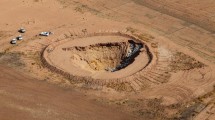Abstract
Mine drainage is a necessary but very costly precaution for open-pit lignite mining in sandy aquifers. Consequently, the minimization of the number of drainage wells and their optimal operation become important tasks in designing mine drainage systems. Comprehensive groundwater flow models have to be used, both, for the design of drainage wells, and for the analysis of water management strategies in mining areas. The accuracy of computations with such models depends on the precision of the underlying hydrogeological informations. In order to get these informations detailed and costly hydrogeological explorations have to be done in the mining regions.
The basic informations are obtained using exploration drilling. The cost for hydrogeological exploration are approximately a linear function of the number of exploration bore holes. Therefore the reduction of drilling gets a key role in reducing costs of exploration. This might be done by:
-
- increased use of geophysical exploration methods,
-
- complex analysis of exploration results using mathematical statistical methods,
-
- precise estimation of the required amount of hydrogeological informations.
The paper describes a mathematical approach to support the complex decision making procedure of estimating the optimal amount of hydrogeological exploration with respect to a given mine drainage goal.
Similar content being viewed by others
References
Reisner, H. and Rösch, L., Entwicklungstendenzen der Tagebauentwässerung im Braunkohlenbergbau (Trends in open-pit mine drainage in lignite mining). Leipzig, Neue Bergbautechnik, Vol.14, No. 7, pp. 260–261 (1984).
Kaden, S. et al., Analysis of regional water policies in open-pit lignite mining areas. Laxenburg, Austria, IIASA WP 85-04, 67 p. (1985).
Kaden, S., and Luckner, L. Groundwater management in open-pit lignite mining areas. Intern. Symposium on Groundwater Resources Utilization, Montreal, Canada, May 21–23, 1984, Vol.I, pp. 69–78 (1984).
n.n., Methodik zur Erkundung von Braunkohlenlagerstätten (Methods for exploration of lignite deposits). VEB Geol. Forschung und Erkundung, Halle, GDR (1976).
Bamberg, H.-F., Stoyan, D., and Garling, F., Beitrag zur Ermittlung der erforderlichen Erkundungs- und Erschliessungsarbeiten (Contribution to the estimation of the number of required bore holes for hydro geologic exploration and drilling), Berlin, Wasserwirtschaft/Wassertechnik, Vol.25, No.2, pp. 57–59 (1975)
Goldbecher, K., and Eckardt, G., Zur Modellierung von Lagerstaetten fluider Rohstoffe (About modelling of fluid resources deposits). Berlin. Zeitschrift fuer Angewandte Geologie, Vol.28, No.1, pp. 1–6 (1982).
Reichel, F. and Lomakin, J.A., Ermittlung des erforderlichen Aufwandes der hydrogeologischen Erkundung in Bergbaugebieten auf der Grundllage hypothetischer hydrogeologischer Modelle (Estimation of the required amount in the hydrogeological exploration in mining areas on the basis of hypothetical hydrogeological models). Leipzig, Neue Bergbautechnik, Vol.14, No.1, pp. 15–17 (1984).
Virdee, T. S., and Kottegoda, N. T., A brief review of kriging and its application to optimal interpolation and observation well selection. Hydrological Sciences Journal, Vol.29, No.4, pp. 367–387 (1984).
Beims, U., and Luckner, L., Grundlagen der Ermittlung representativer Durchlaessigkeitsparameter (Contribution to the estimation of representative transmissivities). Berlin, Zeitschrift fuer Angewandte Geologie, Vol.20, No.7, pp. 304–313 (1984).
Luckner, L., Peukert, D., and Loeffler, H., Beitrag zur Berechnung des durch Sickergraeben, Brunnenreihen oder Draenleitungen gewinnbaren Infiltrates aus Oberflaechengewaessern (Contribution to the estimation of the infiltrate from ditches, well galleries and drains). Berlin, Wasserwirtschaft Wassertechnik, Vol.19, No.5, pp. 168–174 (1969).
Reichel, F., Beitrag zur stochastischen Simulation der horizontal-ebenen Grundwasserströmung unter besonderer Berücksichtigung von Belangen der Projektierung für die Entwässerung (Contribution to the stochastic simulation of horizontal plane groundwater flow with special regard to mine drainage design). Dresden, Dissartation, Technical University (1979).
Reichel, F. et al., Geohydraulic Computation for Open-Cast Mine Dewatering. 1.st. Congress of the IMWA, Budapest, 1982, Proceedings A, pp. 246–259 (1982).
Scheffler, E., Einfluehrung in die Praxis der statistischen Versuchsplanung (Introduction in the practice of statistical design of experiments). VEB Deutscher Verlag fuer Grundstoffindustrie, Leipzig (1974).
Schneeweiss, H., Entscheidungskriterien bei Risiko (Decision criterias under risk). Springer-Verlag, Berlin, Heidelberg, New York (1967).
Author information
Authors and Affiliations
Rights and permissions
About this article
Cite this article
Reichel, F., Luckner, L. & Kaden, S. Estimation of the required amount of hydrological exploration in lignite mining areas on the basis of hypothetical hydrogeological models. International Journal of Mine Water 4, 1–20 (1985). https://doi.org/10.1007/BF02498189
Issue Date:
DOI: https://doi.org/10.1007/BF02498189




